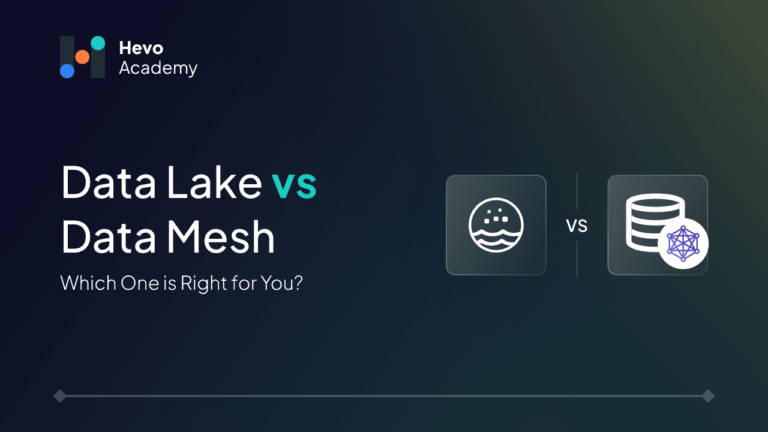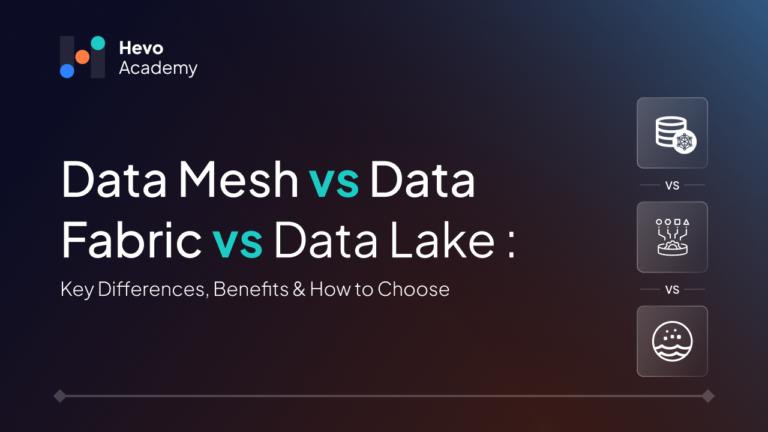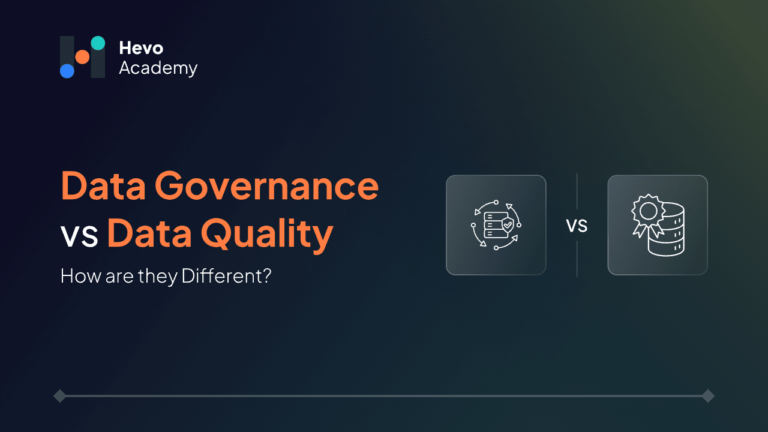Data Management is crucial, and here come its two distinct concepts: Metadata Management vs Master Data Management. Although metadata management and master data management are related, they are very distinct in purpose and focus. Let’s go through both of these in detail.
Table of Contents
Effective data management is essential for modern businesses to succeed in the competitive terrain of today’s data-driven world. Organizations may discover insights, spur growth, and keep a competitive edge by prioritizing data management. In today’s digital era of big data, data management has numerous advantages, some of which are listed below:
- All the processes and jobs become streamlined and efficiently operational.
- There will be less room for expensive errors if wise decisions are made on time.
- Insightful data insights, quality management, and intelligence reports ensure a competitive edge among businesses.
- With regulatory compliance, any sort of data breach and cyber-attacks are reduced.
- Efficient data management results in client engagement, a boost in sales, and an increase in revenue growth.
- Following data governance rules and regulations results in the prevention of legal and financial losses.
Metadata management and master data management are two essential components of data management that work together to provide an organization with a thorough grasp of its data assets.
Looking to optimize your data management strategy? Hevo‘s no-code platform simplifies both data integration. Try Hevo and empower your team to:
- Integrate data from 150+ sources (60+ free sources) to ensure comprehensive data coverage.
- Utilize drag-and-drop and custom Python script features for flexible data transformation and enrichment.
- Benefit from a secure and compliant platform with SOC2 compliance for risk management and data protection.
Experience the Hevo difference and join the thousands of customers who have chosen Hevo to streamline their data management processes.
Get Started with Hevo for FreeWhat is Metadata Management?
Metadata management is the process of managing, organizing, and administrating metadata, which is organized data that provides information about other data. Metadata is like an index of a book that tells about the contents of a book. Metadata management collects, organizes, and maintains metadata under some set of rules, policies, and governance. Metadata management includes:
- Data Descriptions
- Data Definitions
- Data Formats
- Data Relationships
- Data Lineage
Metadata management helps organizations understand the context and meaning of their data, making it easier to manage, integrate, and analyze the data for the growth of the organization.
Key Objectives of Metadata Management
Metadata management can offer many benefits, including the ability to define and enforce guidelines for identifying and locating data assets. Metadata management enables organizations to unlock the full value of their data assets, make informed decisions, and drive business success by implementing below key objectives:
- Improve Data Discovery
- Enhance Data Understanding
- Improved Data Quality
- Facilitate Data Integration
- Data Governance Support
- Enhanced Data Analytics
- Eliminate Data Duplication
- Enhanced Data Security
- Meet Regulatory Compliance Standards
- Improve Operational Efficiency
Examples of Metadata Management
A few examples of Metadata Management are:
- Data Catalog
- Library and Archive System
- Scientific Data Management System
- Asset Management System
- Content Management System
Metadata Management Tools and Technologies
Various tools and technologies used for metadata management are:
- Metadata Management Software: Specialized tools like Alation Metadata Management, Collibra, or Informatica Metadata Management.
- Data Catalogs: Tools like AWS Glue Data Catalog, Apache Atlas, or Hive Metastore.
- Data Governance Platforms: Solutions like IBM InfoSphere, Oracle Enterprise Metadata Management, or SAP Data Governance.
Learn Why is Metadata Management Crucial for your Business.
What is Master Data Management?
Master Data Management (MDM) focuses on processes and techniques for managing an organization’s core data entities, such as customers, products, suppliers, employees, and other business entities. MDM ensures that these critical core data entities are accurate, consistent, and up-to-date across the organization, providing a single source of truth.
Key objectives of Master Data Management
The following are the primary key objectives of Master Data Management:
- Efficient Data Security and Privacy
- Improved Data Consistency and Accuracy
- Reduce Data Redundancy
- Enhanced Decision Making
- Streamlined Data Governance and Compliance
- Better Operational Efficiency
- Satisfied Customer Experience
- Seamless Systems and Applications Integration
- Cost Effective
Pillars of Master Data Management
There are five pillars for effective Master Data Management.
- Data Integration: Data integration involves integrating data from different data sources like databases, spreadsheets, and external sources with integrity and security. Collect all sorts of information and make a central hub to store the same to ensure data is accessible, manageable, and usable throughout the organization.
- Data Quality Management: Once the data is integrated, it is cleaned, validated, and checked for data quality. Data quality needs to be kept in check and maintained for its accuracy, quality, and consistency from time to time. Data quality management includes checking for data errors, missing values, duplicate data, or any inconsistency in data.
- Data Cataloging: In data cataloging, the listing is done for data details, its purpose, the person responsible for their maintenance, and other relevant information. Metadata is used to tag, index, and store datasets. Data Cataloging enables data engineers to find relevant information in one place resulting in efficiency and performance improvement.
- Data Profiling: Data Profiling is the process of examining and analyzing data and making beautiful and meaningful summaries out of it. It helps in producing critical insights out of data which can become very helpful in finding errors in data that can be leveraged by organizations for their benefits. It also extracts patterns, trends, and relationships that help in decision-making for the company’s growth and future.
- Data Governance: Only cleaned and validated data is not sufficient, it should be compliant with governance and regulations policies. This may entail implementing data security and privacy safeguards, as well as complying with regulatory standards.
Examples of Master Data Management
A few examples of Master Data Management are:
- Customer Data Management
- Product Data Management
- Supplier Data Management
- Employee Data Management
- Asset Data Management
- Location Data Management
Master Data Management Tools and Technologies
Various tools and technologies used for master data management are:
- Master Data Management Software: Specialized solutions like SAP Master Data Governance, Oracle Master Data Management, or IBM InfoSphere Master Data Management.
- Data Integration Tools: Solutions like Hevo Data, Informatica Master Data Management Solutions, or Microsoft SSIS.
- Data Governance Platforms: Tools like Collibra, Alation, or Data World.
Master Data vs Metadata
Metadata is data used to represent other data and describe its structure, context, and meaning. It is a roadmap to a data warehouse that makes it easier to manage, integrate, and analyze. Metadata is like an index to a book that tells about its contents.
Master Data describes an organization’s fundamental data elements for decision-making and business operations. It is like the core points highlighted in a book that gives core information about business processes.
Your master data will be better if your metadata is better. To optimize data management practices, it’s essential to understand how metadata and master data differ, as each plays a specific role in maintaining data quality and accessibility. So, Let’s compare Metadata and Master Data in a tabular manner.
| Criteria | Metadata | Master Data |
| Definition | Data that describes other data | Critical data entities (e.g., customers, products) |
| Purpose | Data context and meaning that enable data discovery, quality, and governance | For core business data provide a single source of truth |
| Data Scope | All types of data | Specific master data entities |
| Role in Data Governance | Ensure data security and compliance | Ensures accuracy, integrity, accountability, and consistency |
| Management Focus | Metadata management | Master Data Management (MDM) |
| Integration Complexities | Real-time integration with high volume, variety, and complex data | Seamless integration while maintaining data quality and governance |
Tabular Difference between Metadata Management vs Master Data Management
We can compare metadata management and master data management using different parameters.
Architectural Approach
| Metadata Management | Master Data Management |
| Focus on managing and administrating data that describes other data refer as content data or master data.It occurs at the application level. | Focus on linking core business data entities into a common reference point.It occurs at the enterprise level. |
Data Scope
| Metadata Management | Master Data Management |
| It encompasses all kinds of data, structured and unstructured, and organizes and stores information in metadata in a structured manner.It stores information about the source, format, structure, and relationships between different data elements.Metadata management is broader and envisions all kinds of data assets. | It deals with structured data which is critical to business operationsIt creates a single master record for each entity in business across internal and external data sources and applications.Master Data Management is narrower and focuses on specific data entities. |
Purpose
| Metadata Management | Master Data Management |
| Enhances data usability, accuracy, and understanding.More accurate data insights and decisions.Easier to meet regulatory and compliance requirements | Ensures data consistency and accuracy across systems.Improves operational efficiencyImprove and effective regulatory compliance. |
Data Governance Role
| Metadata Management | Master Data Management |
| Adhere to data regulatory, compliance, and data privacy standards.Regularly review and audit metadata procedures to ensure effective data management. | Ensure business data is used in a harmonized, secured, and compliant manner.Defines processes and procedures necessary to ensure data security, privacy, and regulatory compliance. |
Implementation Complexity
| Metadata Management | Master Data Management |
| Real-time integration challenges with a variety of data sources, the complexity of data, and the high volume and velocity of data streams.Ensuring the timeliness, consistency, and reliability of the data, and balancing the trade-offs between latency, throughput, and accuracy is a challenge | Data integration is complex across multiple applications and systems but ensures that data is accessible throughout the organization.Data transformation and integrating master data with external systems is quite complex and challenging. |
The Role of Metadata Management and Master Data Management in Data Governance
Metadata management gives information on the data governance policies and procedures in place, and master data management systems are used to manage and govern master data. Both metadata management and master data management play an important role in data governance in the following ways:
- Ensure Data Quality: Data governance establishes norms and standards to guarantee data consistency, correctness, and compliance with business and legal requirements.
- Ensure Data Consistency and Traceability: It ensures that any change in data is tracked down regularly and checked for security and consistency throughout the data life cycle.
- Operational Efficiency Improvement: Strategic data integration, interoperability, and reuse lowers redundancies and inefficiencies and optimizes data management operations, enabling businesses to function more successfully.
- Refine Data Compliance: Refined and precise levels of data governance, data security, data privacy, and compliance with regulatory requirements are regulated.
- Improved Decision Making: Metadata and master data management establish all norms, processes, and policies and implement them to aggregate and use data for improved, effective, and result-oriented decision-making.
Conclusion
In summary, metadata management ensures data quality and integration. It validates data transformation, while master data management is a critical aspect of modern data management that supports critical business processes and operations with accuracy and consistency. Both are essential for effective data management and compliance data governance.
Schedule a personalized demo with Hevo for robust data management.
Frequently Asked Questions
1. What is an example of metadata management?
An example of metadata management is organizing and documenting data schemas, file formats, and data lineage to help users understand and utilize data effectively.
2. What is the difference between MDM and CDM?
Master Data Management (MDM) focuses on creating a single, accurate view of critical business data across an organization, while Customer Data Management (CDM) specifically deals with managing customer-related data.
3. What are the three types of master data?
The three types of master data are people data (customers, employees), product data (items, materials), and location data (addresses, regions).
4. What is the difference between ETL and master data management?
ETL (Extract, Transform, Load) is a process for integrating and preparing data for analysis, while Master Data Management (MDM) involves managing and ensuring the consistency of critical business data across systems.





